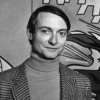Roy Lichtenstein

Roy Lichtenstein
Roy Fox Lichtensteinwas an American pop artist. During the 1960s, along with Andy Warhol, Jasper Johns, and James Rosenquist among others, he became a leading figure in the new art movement. His work defined the basic premise of pop art through parody. Favoring the comic strip as his main inspiration, Lichtenstein produced hard-edged, precise compositions that documented while it parodied often in a tongue-in-cheek manner. His work was heavily influenced by both popular advertising and the comic book style. He...
NationalityAmerican
ProfessionPop Artist
Date of Birth27 October 1923
CityNew York City, NY
CountryUnited States of America
I kind of do the drawing with the painting in mind, but it's very hard to guess at a size or a color and all the colors around it and what it will really look like.
Color is crucial in painting, but it is very hard to talk about. There is almost nothing you can say that holds up as a generalization, because it depends on too many factors: size, modulation, the rest of the field, a certain consistency that color has with forms, and the statement you're trying to make.
My use of evenly repeated dots and diagonal lines and uninflected color areas suggest that my work is right where it is, right on the canvas, definitely not a window into the world.
Color is crucial in painting, but it is very hard to talk about.
I'm interested in what would normally be considered the worst aspects of commercial art. I think it's the tension between what seems to be so rigid and cliched and the fact that art really can't be this way.
Pop Art looks out into the world. It doesn't look like a painting of something, it looks like the thing itself.
I'm not really sure what social message my art carries, if any. And I don't really want it to carry one. I'm not interested in the subject matter to try to teach society anything, or to try to better our world in any way.
I think we're much smarter than we were. Everybody knows that abstract art can be art, and most people know that they may not like it, even if they understand there's another purpose to it.
But certainly the Abstract Expressionists were in a more romantic mode of painting, or give and take, than my paintings are seen to be anyway.
But when I worked on a painting I would do it from a drawing but I would put certain things I was fairly sure I wanted in the painting, and then collage on the painting with printed dots or painted paper or something before I really committed it.
Picasso's always been such a huge influence that I thought when I started the cartoon paintings that I was getting away from Picasso, and even my cartoons of Picasso were done almost to rid myself of his influence.
Yeah, you know, you like it to come on like gangbusters, but you get into passages that are very interesting and subtle, and sometimes your original intent changes quite a bit.
I dont have big anxieties. I wish I did. Id be much more interesting.
Personally, I feel that in my own work I wanted to look programmed or impersonal but I don't really believe I am being impersonal when I do it. And I don't think you could do this.